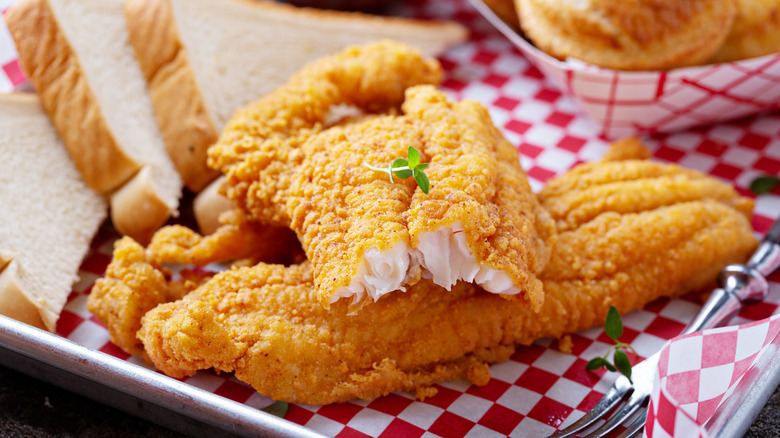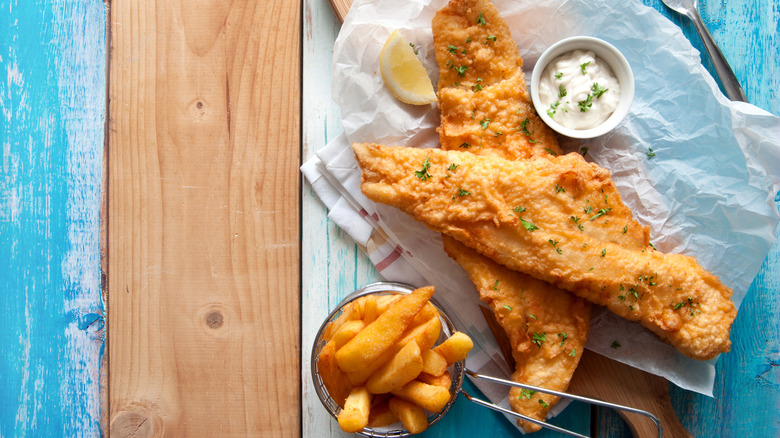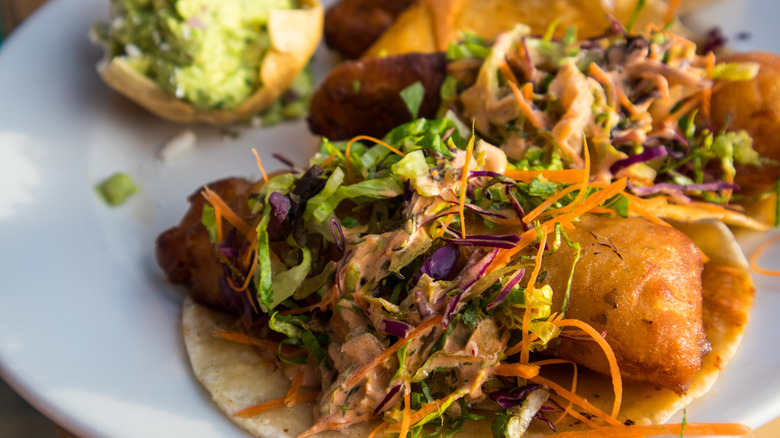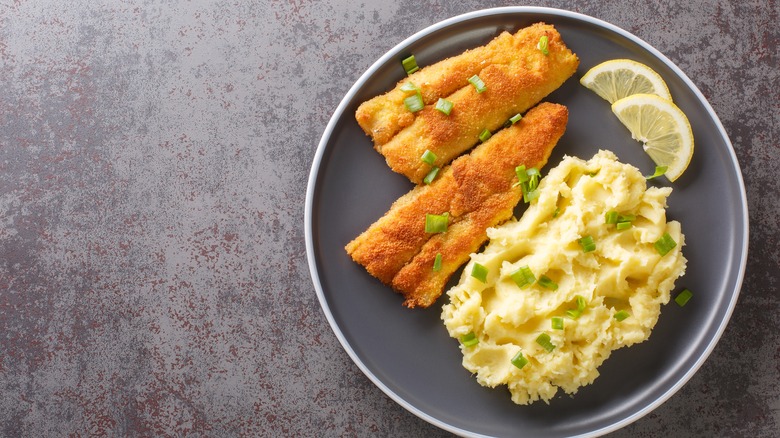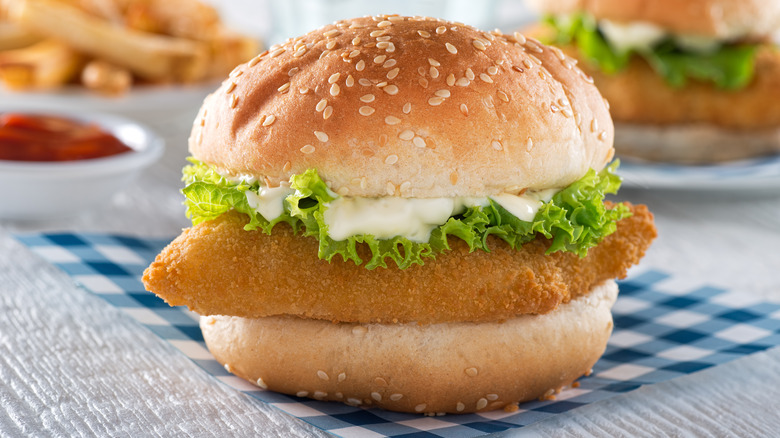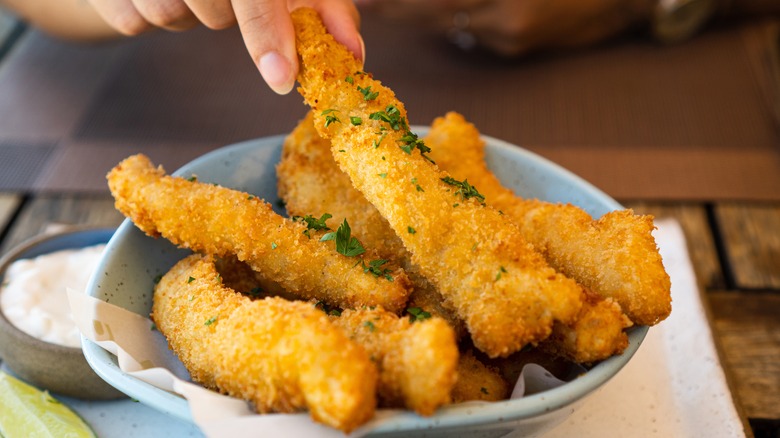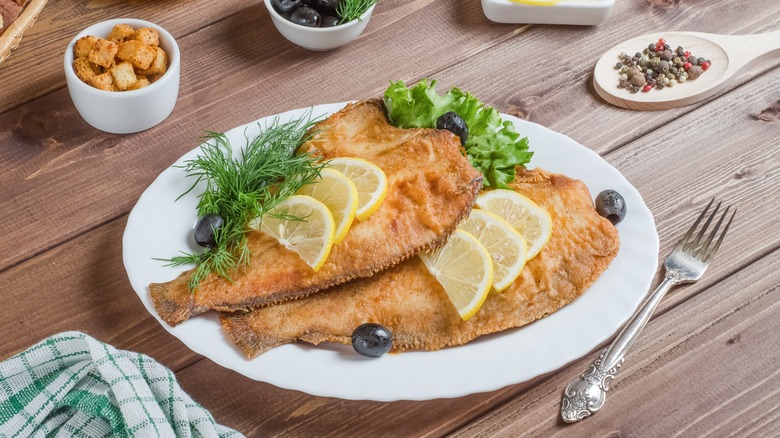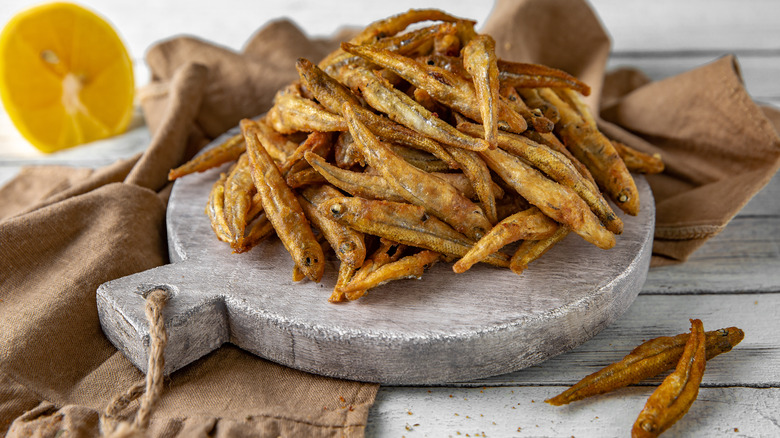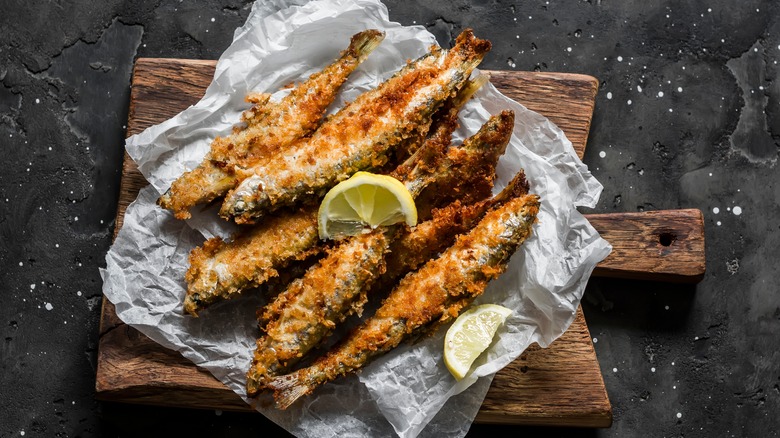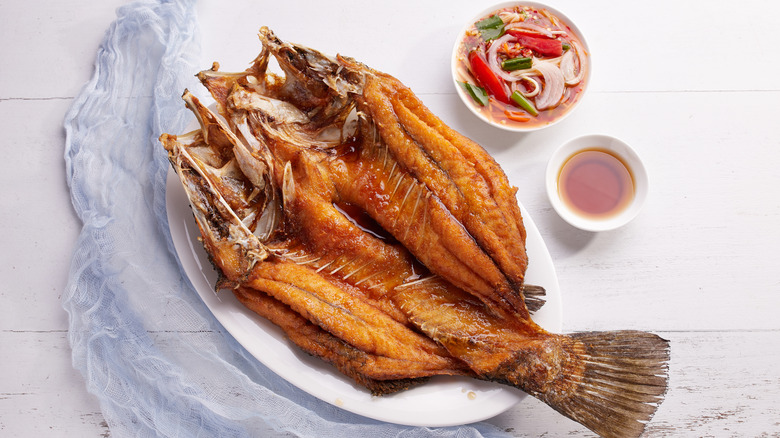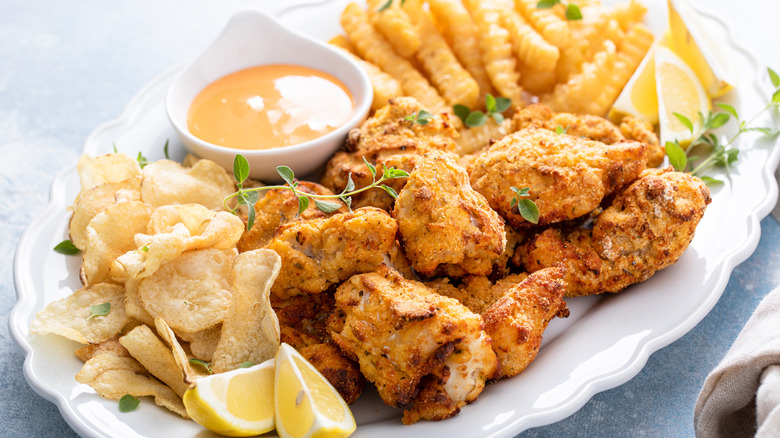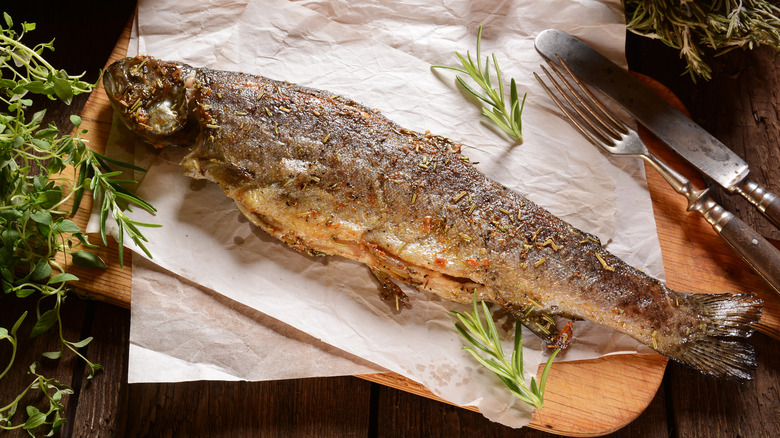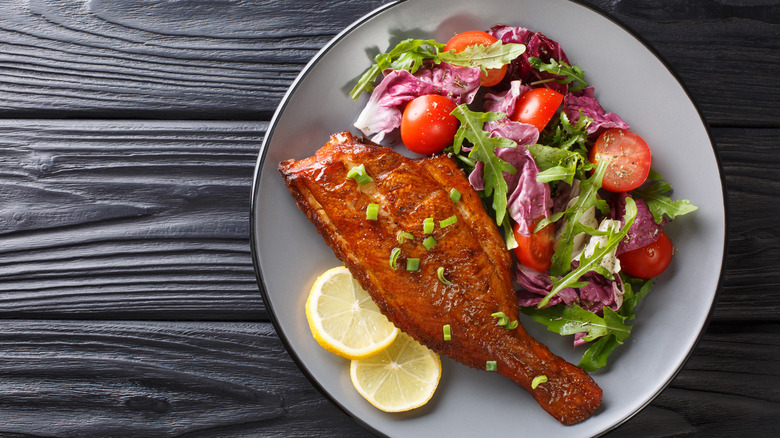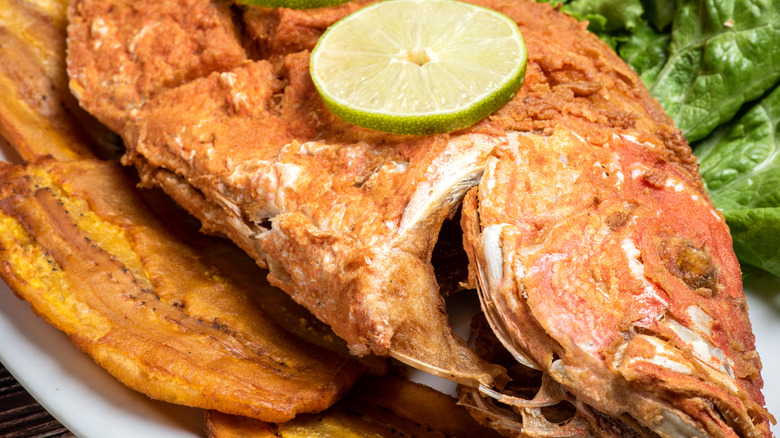13 Best Types Of Fish That Hold Up Well To Frying
With Lent upon us, it's the time of year when fish is the topic of conversation more than usual. It is customary for Catholics not to eat meat (from warm-blooded animals) on Fridays during the Lenten season (this is considered universal law of the Latin Church). Because fish are cold-blooded animals, their "meat" is excluded from this rule, and it has long been a common practice for Catholics to consume fish on Fridays during Lent in place of meat.
There are endless ways to prepare fish, and one such way is frying. Although not considered the most nutritious way to consume this protein source, crispy golden pieces of fish bring joy to our taste buds. If you are wondering if there could possibly be that many different ways to fry fish, you might be surprised. There is a lot of variation that can be applied, but even more, what you will find is how many types of fish do well with frying. Certainly, not all are worthy of a hot oil bath, but we are breaking down the absolute best options for frying to help you out during your Fish Fridays this Lent.
Cod
Lean, mild-flavored white fish are particularly well-suited for frying. When listing off fish in this category, cod likely is the first to come to mind for many. This age-old flaky white fish is a staple for fish lovers. There are two common varieties of cod. Atlantic cod has a semi-firm texture that easily flakes apart once cooked. Pacific cod, which has a firmer texture, is more known for grilling or baking, but it can also be fried.
Cod is the traditional choice for classic British fish and chips. This species is available on both sides of the Atlantic, where you see this dish popularly consumed both in the UK and New England. It was English Puritans who settled the region's colonial towns, cementing a lasting legacy on the local cuisine. Cod is also the go-to for fish and chips because it holds together well when battered and deep-fried, but the meat will still feel tender and light. It also has a mild flavor with a subtle sweetness.
The main downfall of Atlantic cod, however, is that it has been heavily overfished. However, domestic fisheries have been working to rebuild the population through harvest limitations, according to NOAA.
Haddock
Also a flaky whitefish, haddock has gained a reputation as being a suitable replacement when you can't get your hands on cod. However, this North Atlantic species deserves attention on its own merit.
Cod fillets are large and dense, but haddock offers a softer and more tender texture. It will hold together well in the fryer, but you can expect an even flakier experience compared to cod. The fish will flake apart after cooking at the gentlest of touch.
Haddock's soft texture makes it a great choice for fried fish tacos. A light beer batter on the fish will provide a crisp, puffy texture while maintaining a tender interior. You can provide additional texture from the cabbage slaw topping, but deep-fried haddock when not overly coated with batter, will not sit too heavy in your stomach. One thing of note is that if you are someone with a sensitive palate, haddock is known for having a fishier taste compared to cod, which is fairly neutral in flavor.
Hake
The Northern Atlantic Ocean is home to several groundfish species that are considered good frying fish in New England. (Groundfish refers to fish that swim close to the ocean floor.) Among them is hake, which is a popular fried fish option. Because it is so readily available and typically lower in price, hake has unfairly been overlooked as a cheap fish. This fish is very soft, so it does need to be treated with care during processing, but it has its distinct culinary benefits. Once cooked, you'll find these tender, moist, and uniquely wide flakes that give an elegant presentation.
Given its delicate texture, hake is better suited for a shallow pan-fry. Instead of using a batter, we recommend a classic breading station with seasoned flour, beaten eggs, and breadcrumbs (such as panko) dipping the fish in a shallow dish of each item in that order. Even with just an inch or so of neutral oil, you will get a nice, golden brown crust to contrast against the soft meat.
Pollock
Another member of the Gadiformes order that's suitable for frying is pollock. Found on both the Atlantic and Pacific coasts, pollock is commonly mistaken as a good substitute for cod, thinking they can be used interchangeably. The confusion is understandable given that pollock is a member of the cod family. However, there are some key differences between cod and pollock.
Like hake, pollock has a soft, delicate texture that doesn't hold up as well as cod to deep-frying (the fish's very thin flakes make it more comparable to haddock). Pollock takes much better to being pan-fried, or minced and formed into patties that get breaded and fried. (Alaskan pollock is commonly found in commercially produced fish sticks.) It's also the fish used in the current iteration of McDonald's famous Filet-O-Fish sandwich, a fast food creation that was specifically designed with Lent in mind.
While Alaskan pollock is more widely consumed in the United States, the Atlantic variety is also good for frying, although it is a different species from the cod family. Atlantic pollock has darker, fattier fillets, while the Alaskan species is leaner and has more of the classic whitefish appearance.
Tilapia
Perhaps no fish has received more hate than tilapia. Chefs often call it a tasteless, fake fish. Others accuse this widely farmed species as being dirty and cheap, but it is time to dispel some rumors about this controversial species.
Despite popular belief that tilapia was created in a lab, this family of fish is native to Africa. The concept of farming tilapia is not a modern thing either. Ancient Egyptians were using aquaculture to produce these fish. Tilapia are now cultured in over 135 countries, and serious concerns have been raised about the health and safety of some global farming practices. Healthline reports that the FDA has found some tilapia coming from China to be contaminated with harmful chemicals.
Yet when sustainably produced, tilapia can be a great fish to eat. Its mild taste makes it popular with people who claim they don't like fish. Given that it is affordable and plentiful, it can be a good introductory fish for people wanting to add more seafood into their diet. Tilapia is another one that does well with pan-frying, but you do need to handle the filets with care since this fish is very delicate. The biggest mistake to avoid when pan-frying fish like tilapia is moving the fillets in the pan too much. To keep it from falling apart, it is best to leave the fish undisturbed and only touch it to flip.
Flounder
Flatfish fish like flounder have versatile frying applications. You can fry the whole fish, just the fillets, or even roll and stuff the fillets before frying. As the name suggests, flatfish have flat bodies, and they swim and lay sideways in part to help camouflage themselves from predators. Instead of two fillets from each fish, they have four total (two on each side of their body). They are also considered groundfish since they live on the ocean flour. Many common flatfish are technically flounder, but we know them as different names such as sole, plaice, and dabs. For simplicity, we are referring to this group of fish here as flounder.
Flounder fillets are typically thin and cook very quickly. If frying just the fillets, pan-frying would be best to prevent overcooking. You can stuff the fillets with vegetables like spinach and tomatoes before rolling into spirals and dipping those in breadcrumbs before pan-frying. Consider a classic stuffed flounder recipe with a creamy crab meat filling, which could be another delicious way to prepare this fish pan-fried. Given their size, flounder can also be good fish to fry whole. Deep-fried or shallow pan-fried, you can get beautiful brown skin on flounder, and all you really need to do is dredge them in seasoned flour beforehand. When you start digging into the fish, the tender meat will lift right off the bones.
Smelts
Some people may call them bait. Others consider them a treat. And then there are those who haven't even heard of them. But there's no denying that smelts are ideal frying. These tiny treats are a family of tiny silver-skinned fish that live most of their lives at sea, but they return to freshwater sources to spawn. The species you'll most likely come across is the rainbow smelt, which are typically about 6 inches long.
Smelts are popular around the Christmas and Easter holidays, especially for Italian Catholics. Depending on your local fish market, you may see them sold whole and dressed (guts removed), or they may also have the heads removed. Either way, toss them in seasoned flour and deep fry until golden brown. Give them a sprinkling of salt after they come out of the fryer like you would other deep-fried foods.
Smelts do have bones, but they are so small and faint that after cooking, you can eat these fish whole and enjoy the extra crunch. If you can get some smelts this year for Lent, make yourself some fries with eyes. They are in peak season through spring, and they make a good appetizer to feed a crowd — just don't forget the tartar sauce.
Sardines
At first glance, sardines may seem like larger smelts, but they are a unique seafood offering. A member of the Osmeridae family, smelts are closely related to salmon and trout, whereas sardines are from the Clupeide family, making them relatives of herring.
You may be more familiar with sardines that come in a can, but when available fresh, these fish are excellent fried. Sardines have a lot of similarities to mackerel. These are oil-rich fish, but with a tender white flake when cooked. Fresh sardines (if truly fresh) won't have a strong fishy taste, but you should get that natural salinity to come through.
Sardines don't need much more than being dredged in flour before frying. In our recipe for chili-garlic pan-fried sardines, we take the concept of simple fried fish to the next level. The sardines get a light dusting of flour, but by pan-frying them in oil where you also fry garlic and red chili flakes, the flavor is amplified.
Bass
Fish have a lot of names and categories. It can be hard to understand how all the groupings are formed, and bass is a good example as the term covers many different freshwater and ocean species. As they are part of the Perciformes order, technically these are all considered perch-like fish.
Largemouth bass, in particular, are great for frying. This type of bass is a favorite among recreational fishers, probably because they have such a wide range in freshwater bodies throughout the United States. In the South, it is common to see largemouth fillets cut into smaller pieces, breaded with cornmeal, and then deep fried.
Also called black bass, largemouth bass should not be confused with black sea bass. Sea bass can weigh over 8 pounds, but most caught commercially are under 4 pounds, making this fish a good choice for frying whole. It helps to score the dark skin before frying, but you can expect a tender but firm fish with a golden brown appearance.
Catfish
If there is one fish that evokes thoughts of soul food, it would be catfish. This seafood item is popular throughout the South, but especially in Louisiana. There are many different species of this fish, but blue catfish is what's indigenous to the Mississippi River basin, making Cajun country a natural place for them.
There are a few key characteristics that differentiate a Southern fish fry from other fried fish. First, the fish will have most likely been soaked in buttermilk. Second, instead of breadcrumbs, the fish is coated in a cornmeal mixture. Finally, the dipping sauce is going to be a remoulade or another similar type of sauce. (When compared to traditional tartar sauce, remoulade is bolder and spicier in the flavor department.)
A traditional Southern catfish fry could be a great Lenten, but why not try something just a little different? Our catfish nugget recipe offers all the essence of fried catfish, but with bite-size pieces, they cook up quicker than listing all the ingredients in Old Bay seasoning. These would go really great with a side of hush puppies and a cold beer.
Trout
Another diverse grouping, trout are freshwater fish that belong to the same family as salmon. They range in size, taste profile, and color. Red rainbow trout, which much more closely resembles salmon, is not going to be ideal for frying. Similarly to its orange-fleshed cousins, red rainbow trout is better suited for pan-searing or baking, as frying it would introduce too much oil to an already fatty fish.
There are other varieties of rainbow trout, however, that have a pale pink tint and are much smaller in size. These fish are raised in lakes and rivers throughout the United States, making this other popular species for recreational fishing. Rainbow trout are actually native to the region of North American west of the Rocky Mountains. These fish do very well with frying, and when they haven't grown too big, they can be fried whole.
Like with all whole fish, when you cook them, they should be gutted, leaving an empty cavity. You can stuff the interior with fresh herbs and lemon slices before you pan-fry the fish to infuse more flavor. Keep in mind that you don't need to coat trout in flour. Pan-frying them in oil will get a nice, crispy skin on the fish. Just make sure you pat your trout dry all over before cooking.
Perch
Perch is an overarching term used for fish that fall under the Perca genus, and each region has its own specialty. The Gulf of Maine has gifted us Acadian Redfish (ocean perch)while California is home to vermilion rockfish (vermilion seaperch). Inland, the freshwater species walleye (yellow pikeperch) is found in plenty in the Great Lakes region. (And these are just some examples.) Despite their unique qualities, you can see striking similarities in many types of perch. Acadian redfish and vermilion rockfish look nearly identical with their bright red color, spiny fins, and big, bulging eyes.
Perch species are mild in flavor with just a hint of sweetness that makes them ideal for frying. Fried yellow perch is a Midwest specialty where the breading of choice is crushed saltine crackers. Other types of perch like redfish and rockfish are other good options for fried fish tacos.
Red snapper
This illustrious fish is as tasty as it is beautiful. Red snapper is a member of the Perciformes order, which explains why they look very similar to black sea bass. The Gulf of Mexico is considered the best place to catch red snapper for sustainability purposes, but you can also find them along the Southern Atlantic coast, where they have been overfished, according to NOAA.
Red snapper's nutty white meat with just a hint of brine has made this fish popular in Japanese cuisine, revered for raw preparations in sushi restaurants. However, not all those applications necessarily need to be served raw. Japanese tempura is a frying batter made irresistibly light and crispy thanks to corn starch and club soda, and it pairs well with snapper. In our recipe for tempura red snapper banh mi, pieces of snapper fillet get the frying treatment for one to two minutes until golden brown and crispy. In the Caribbean, red snapper is a fried favorite. The Dominican Republic, Haiti, and Jamaica all have their version of whole fried snapper with delicious crispy skin. Dominican pescado frito (which is often prepared with red snapper) is traditionally served with a side of plátanos (fried green plantains).
